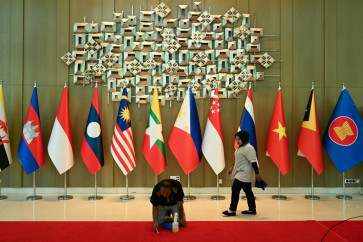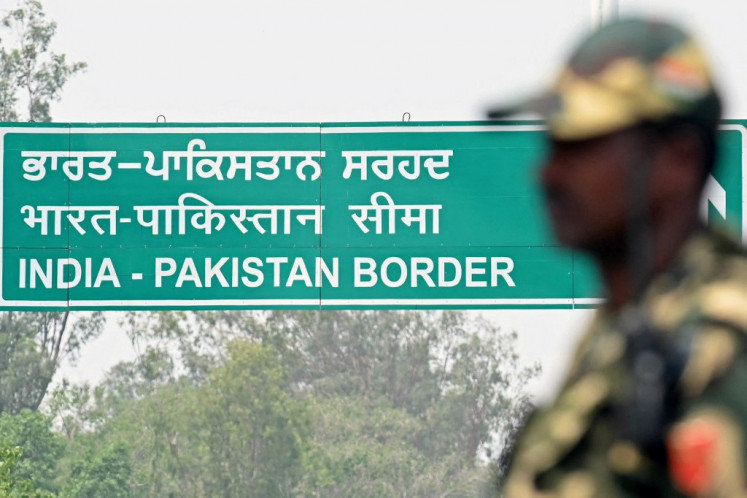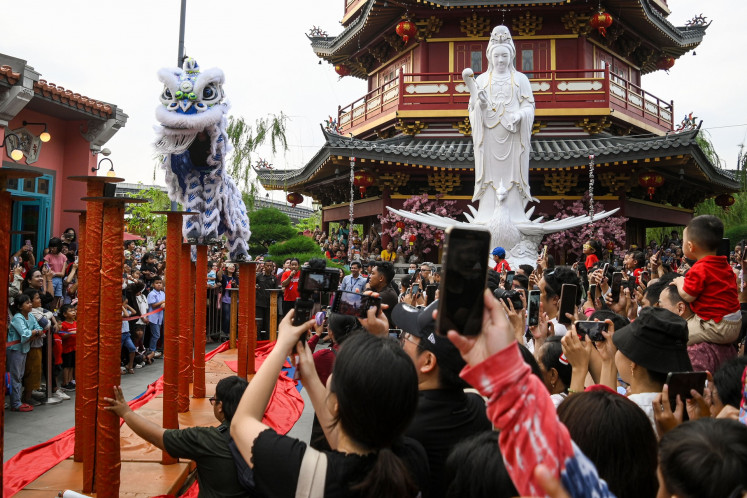The journey of Islam in maps
Charted: Seminar attendees browse through maps presenting the religious, political and cultural history of Islam
Change text size
Gift Premium Articles
to Anyone

C
span class="caption" style="width: 468px;">Charted: Seminar attendees browse through maps presenting the religious, political and cultural history of Islam. JP/Dina Indrasafitri University students wearing headscarves knitted their eyebrows in concentration last week in Jakarta as they listened to an explanation of combat tactics used by the Prophet Muhammad in his battles during the early days of Islam.
But the person giving the explanations sported neither a headscarf nor a turban or beard. He was dressed in the typical Western attire of shirt and slacks, speaking English with a heavy Italian accent.
Despite a moment of seemingly hesitant silence after he finished his lecture, questions and discussions got livelier as cartographer Giovanni de Agostini, Jr. took the students and other participants that day to see the maps he had brought with him to Jakarta for the exhibition “History of Islam” at the National Museum.
Several followed him as he took them on a tour to explain the stories contained in the maps.
De Agostini is the descendant of famous Italian cartographers. His forebear, Giovanni de Agostini, founded the first private geographic institute, the Istituto Geografico de Agostini, in Rome in 1901. The company produced maps and atlases for Italy so that the country no longer had to depend on foreign-made maps.
Over 20 of the maps featured in the exhibit are laid out in chronological order, following the spread of Islam as a religion as well as a political power in various parts of the world.
The maps begin to tell the story of the world’s situation at Muhammad’s birth. Viewers can then look at later events, such as the Prophet’s journey from Medina to Mecca where he and his followers spread Islam from 632 to 661 A.D. during the period of the four caliphs: Abu Bakr, Omar, Uthman and Ali.
The cartographic journey continues with the period of Arab conquest in lands such as Syria and Mesopotamia from 632 to 714, the period of the Mongol Empire founded by Gengis Khan, the series of wars termed the Crusades, the Ottoman Empire’s rise to power and its decline, as well as the spread of Islam in Indonesia.
The maps are mostly in Arabic, but translations of the legends in English are made available at the bottom.
Arabs for a certain period in history were known to be highly developed in the art of cartography, and the exhibition includes a replica of a famous map of the world made in the 12th century by geographer Muhammad Al-Idrisi.
A booklet explaining the journeys of various empires and rulers is available in limited supply to accompany the maps.
According to De Agostini, he tried to include various points of views of Arab history. “Before, [there were] different atlases with different points of view. My point of view is zero,” he said, emphasizing his effort to remain free from prejudice.
Included on the exhibition’s agenda were seminars in which De Agostini spoke about the cartographic problem that was solved with the realization of mapping in the period of the Prophet, the Rasyidun and the Ummayad, and about Muhammad’s four battles to an audience mostly composed of students.
De Agostini said the “History of Islam” exhibit is the fruit of 14 years of work, in which he traveled to various countries in the world and worked with professors from various universities, including in Cairo, Baghdad, Naples, Madrid and Bonn.
This is the first time the exhibition has been held. Indonesia was chosen because it has the highest number of Muslims, and the next stop for the exhibition includes countries such as Saudi Arabia.
According to De Agostini, the work had been a challenging one, especially the parts involving the early days of Islam due to the absence of written histories and the often contradicting accounts of events and
locations from different sources.
One example is his problem defining the exact location of the battle of Badra between Muslims and the Quraish of Mecca, which took place in 624 AD.
“I understand only [that the location] is three days by camel from Medina. The valley is in the direction of northeast, southwest, [it] has one well in the middle. To locate this valley it is necessary to understand if one camel [goes] speedily, how many kilometers [it will go] in one day. I put one circle. One camel goes slowly, I put another circle. In this part, I look into how many valleys have all these characteristics. One is very little, it’s not possible to have a battle inside, [so] I use another one,” De Agostini said.
Problems also sometimes surfaced when his work touched upon subjects that involve conflicting interests between Sunni and Shiite, he added.
Almost inevitably, journalists began asking him why he, being an Italian non-Muslim, is doing work about the history of Islam. De Agostini’s replies included that human beings should look back in history for similarities instead of differences. He also cited science and knowledge as his reasons.
Islamic civilization has contributed much to the world, including the science of cartography, arts, culture and medicine, he said.
According to De Agostini, one of the reasons Muhammad succeeded in achieving such power during the days of Islam was the lack of one unifying force in the Arab peninsula at that time, and it was a simple move for the Prophet to assume more power once he occupied the more important Mecca.
The Islamic conquests were also made easier by the exhausting wars between the Byzantine Empire and Sassanid dynasty, he added.
De Agostini said his work curating the exhibit led him to an understanding of Islam that is in some ways different from what he learned in school.
One example is the stories involving the Sultan Saladin, known to have reigned in the 12th century. He discovered that Saladin was a wise ruler instead of the dictator portrayed in lessons in some schools.
“During [Saladin’s] rule, Jews, Christian and Muslims could live side by side. The only difference between them was that Jews and Christians paid higher taxes than Muslims,” De Agostini said through a translator.
However, what is unfair now is that he cannot go to church when in certain countries, despite it being possible in Saladin’s time, he said.
The “History of Islam” exhibition is sponsored by
the Embassy of Italy and The Italian Institute of Culture Jakarta, in collaboration with L’Antica Cartografia and the National Museum. It runs until June 30 at the National Museum. Admission is free.









